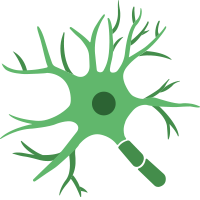
Neural Cell News
Neural Cell News is an online resource covering the latest research in neuroscience, neural stem cells, and neurological conditions.
Black Phosphorus Nanosheets Protect Neurons by Degrading Aggregative α-Syn and Clearing ROS in Parkinson’s Disease
[Advanced Materials] Black phosphorus nanosheets (BPNSs) interacted directly with α-synuclein (α-syn) fibrils to trigger their disaggregation for Parkinson's disease treatment. BPNSs were found to activate autophagy to maintain α-syn homeostasis, improve mitochondrial dysfunction, reduce reactive oxygen species levels, and rescue neuronal death and synaptic loss in PC12 cells.
Distinct Ultrastructural Phenotypes of Glial and Neuronal Alpha-Synuclein Inclusions in Multiple System Atrophy
[Brain] Correlative light and electron microscopy were employed to investigate alpha-synuclein pathology in the substantia nigra and putamen of post-mortem multiple system atrophy brain donors.
Microglial TNFα Controls Daily Changes in Synaptic GABAARs and Sleep Slow Waves
[Journal Of Cell Biology] Scientists demonstrated that sleep induced microglia-dependent synaptic enrichment of GABAARs in a manner dependent on microglial TNFα and P2RX7.
Autism Patient-Derived SHANK2BY29X Mutation Affects the Development of ALDH1A1 Negative Dopamine Neuron
[Molecular Psychiatry] The authors reported a point mutation on SHANK2, which was found in a patient with autism. This mutation resulted in an early stop codon and an aberrant splicing event that impacted SHANK2 transcript variants distinctly. iPSCs carrying this mutation failed to differentiate into functional dopamine neurons.
Cell Adhesion Molecule Signaling at the Synapse: Beyond the Scaffold
[Cold Spring Harbor Perspectives In Biology] The authors provide an overview of the intracellular signaling pathways that are engaged by synaptic cell adhesion molecules and highlight outstanding issues to be addressed in future work.
Disease Related Changes in ATAC-Seq of iPSC-Derived Motor Neuron Lines from ALS Patients and Controls
[Nature Communications] Scientists examined the epigenomic profiles of more than 500 cell cultures of iPSC-derived motor neurons generated from ALS patients and healthy controls to test for the presence of genetically driven, disease-relevant changes in chromatin accessibility and dysregulated transcriptional programs.
A Positive Feedback Inhibition of Isocitrate Dehydrogenase 3β on Paired-Box Gene 6 Promotes Alzheimer-Like Pathology
[Signal Transduction And Targeted Therapy] Scientists reported a substantial decline in isocitrate dehydrogenase 3β (IDH3β) levels, a critical tricarboxylic acid cycle enzyme, in Alzheimer's disease (AD) patients and AD-transgenic mouse brains.
New Perspective on Sustained Antidepressant Effect: Focus on Neurexins Regulating Synaptic Plasticity
[Cell Death Discovery] Using neurexins as a starting point, the current research findings on the effects of neurexins transsynaptic complexes on synaptic plasticity are summarized and their use as a potential new perspective for sustained antidepressant effect is discussed.
Anova to Manage Study of DB107 Following Newly Awarded $11.8M CIRM Grant
[Anova Enterprises, Inc.] Anova Enterprises, Inc. has collaborated with University of California at San Francisco, University of California at San Diego, University of Southern California, and Denovo Biopharma to manage a newly awarded $11.8M California Institute for Regenerative Medicine (CIRM) grant to support the development of DB107 in patients with newly diagnosed high-grade glioma.
Harnessing Nanochaperone-Mediated Autophagy for Selective Clearance of Pathogenic Tau Protein in Alzheimer’s Disease
[Advanced Materials] Investigators developed pathogenic tau-specific autophagy based on customized nanochaperone for Alzheimer’s disease treatment.
D-Peptide-Magnetic Nanoparticles Fragment Tau Fibrils and Rescue Behavioral Deficits in a Mouse Model of Alzheimer’s Disease
[Science Advances] Scientists designed a seven-residue D-TLKIVWC peptide, which not only prevented tau aggregation but also fragmented tau fibrils extracted from Alzheimer’s disease brains to neutralize their seeding ability and protect neuronal cells from tau-induced toxicity.
PARKIN is Not Required to Sustain OXPHOS Function in Adult Mammalian Tissues
[npj Parkinson's Disease] Researchers investigated the mitochondrial role of PARKIN during aging and in response to stress by employing a series of conditional Parkin knockout mice.
Neural Cell News helps scientists keep pace with the latest research, reviews, and industry developments in neuroscience. Specific research topics include neural development and neuroregeneration, neural signaling related to cellular responses and behavior, and synaptic plasticity. Research into the diagnosis, progression, cellular characteristics, and treatment of brain diseases such as Parkinson’s, Multiple Sclerosis, Alzheimer’s, Amyotrophic Lateral Sclerosis and various brain cancers, as well as brain damage resulting from infection, trauma, stroke, seizures, and tumors, is also covered.

 Cancer Stem Cell News
Cancer Stem Cell News Cell Therapy News
Cell Therapy News Dermal Cell News
Dermal Cell News Endothelial Cell News
Endothelial Cell News ESC & iPSC News
ESC & iPSC News Extracellular Matrix News
Extracellular Matrix News Hematopoiesis News
Hematopoiesis News Hepatic Cell News
Hepatic Cell News Human Immunology News
Human Immunology News Immune Regulation News
Immune Regulation News
 Intestinal Cell News
Intestinal Cell News Mammary Cell News
Mammary Cell News Mesenchymal Cell News
Mesenchymal Cell News Muscle Cell News
Muscle Cell News Neural Cell News
Neural Cell News Organoid News
Organoid News Pancreatic Cell News
Pancreatic Cell News Prostate Cell News
Prostate Cell News Pulmonary Cell News
Pulmonary Cell News
